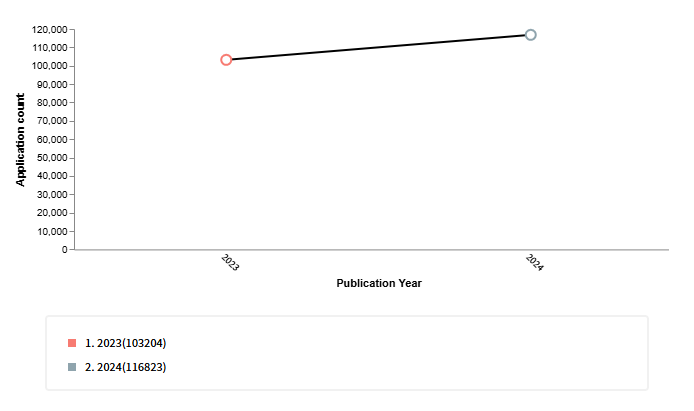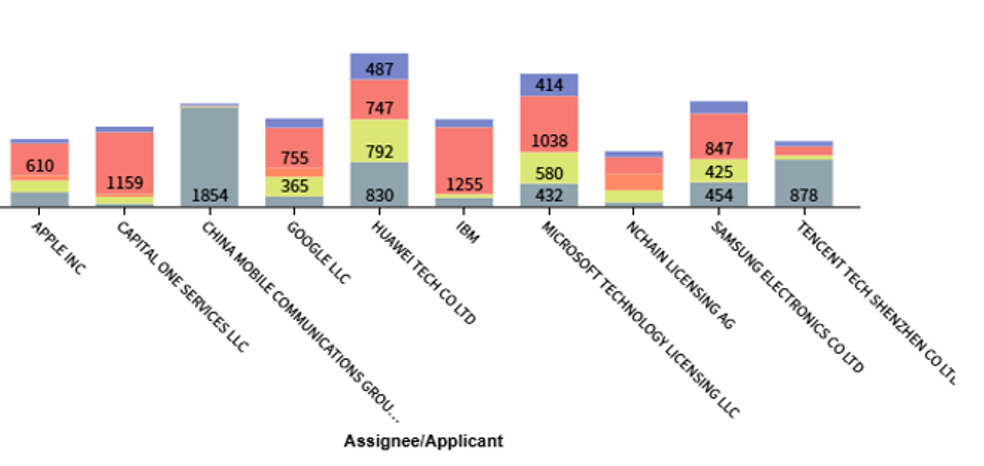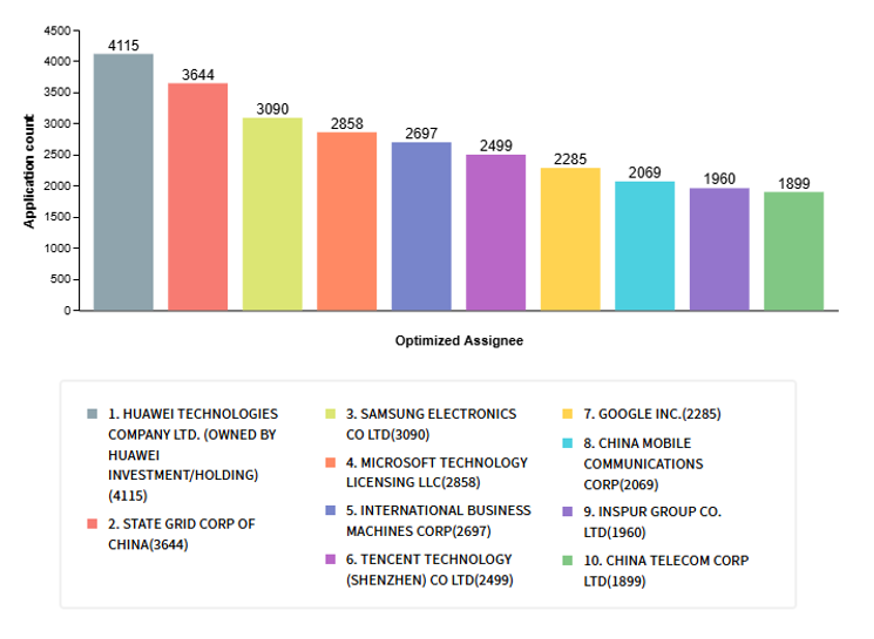Cybersecurity and Intellectual Property The Rising Importance of Patents in Protecting Innovation
In today’s digital age, cybersecurity stands as a critical pillar safeguarding our interconnected world. As cyber threats become increasingly sophisticated, the demand for innovative security solutions has surged, leading to a notable rise in cybersecurity-related patents. This blog delves into the intersection of cybersecurity and intellectual property (IP), highlighting key trends, leading contributors, and the importance of patent protection in this dynamic field.
The Surge in Cybersecurity Patents
Over the past decade, there has been a significant increase in cybersecurity patent applications. According to data from IS Decisions, 97% of cybersecurity patent applications since 2000 have been submitted in the last ten years, underscoring the rapid pace of innovation in this sector. In 2020 alone, patent filings peaked with 453 applications, reflecting heightened efforts to combat evolving cyber threats.
The Rise of Cybersecurity Innovation Global Leaders, Emerging Trends, and Patent Insights
Cybersecurity innovation has seen remarkable growth in recent years, with the United States leading global patent applications, accounting for 45% of all filings since 2000. Asia is also making significant strides, with China, India, the Republic of Korea, and Japan ranking among the top ten countries in cybersecurity patents. A substantial portion of these innovations—58%—focuses on mitigating Denial-of-Service (DoS) and Distributed Denial-of-Service (DDoS) attacks, reflecting the urgent need for advanced security measures. Prominent organizations, including China Electronic Technology Cyber Security Co Ltd, Honeywell, and Argus Cyber Security Ltd, are at the forefront of these advancements. Although cybersecurity patent filings peaked in 2020, a slight decline in 2021, likely influenced by the pandemic, did not diminish the ongoing demand for cutting-edge security solutions. As cyber threats become more sophisticated, continuous innovation remains crucial in safeguarding digital infrastructure and ensuring robust protection for businesses worldwide.
Evolving Cyber Threats
Cybercriminals are constantly refining their tactics, exploiting vulnerabilities with increasing sophistication, and by 2025, cybercrime damages are projected to reach $10.5 trillion annually. A major concern is the evolution of ransomware, which now goes beyond encrypting data to include data exfiltration and public disclosure threats, significantly raising risks for businesses. A stark example occurred in May when the Black Basta group, linked to Russia, attacked Ascension, the largest non-profit Catholic health system in the U.S., crippling operations across 140 hospitals and disrupting access to electronic health records. Beyond ransomware, cybercriminals are leveraging AI to enhance their attacks, with AI-powered malware like IBM’s Deep Locker remaining undetectable until activated and deepfake technology being used to impersonate executives for financial fraud. Supply chain vulnerabilities further amplify risks, while Distributed Denial-of-Service (DDoS) attacks continue to be a major threat, as demonstrated in March 2024, when over 300 web domains and 177,000 IP addresses linked to the French government were targeted, disrupting critical public services. These growing threats underscore the urgent need for proactive and advanced cybersecurity strategies in an increasingly digital world.
Patent Publishing Trends A Rise in Innovation

Source: Retrieved through Derwent Innovation
The patent publishing trends for 2023 and 2024 show a steady rise in innovation, with 103,204 applications published in 2023 and 116,823 in 2024, totalling 220,027 applications across both years. This increase highlights a growing focus on securing intellectual property, driven by rapid technological advancements and competitive market dynamics. The upward trajectory suggests that organizations and inventors are prioritizing patent protection to safeguard their innovations, reinforcing the critical role of intellectual property in fostering technological progress and maintaining industry leadership.
Patent Filings by Top Assignees Across Countries and Regions


Source: Retrieved through Derwent Innovation
The graph highlights the top companies leading in patent filings across various countries and regions, showcasing the global race for innovation. China Mobile Communications Group leads with 1,854 applications, emphasizing China’s strong presence in technological advancements, while IBM and Microsoft Technology Licensing LLC dominate among U.S.-based applicants with 1,255 and 1,038 filings, respectively. Apple Inc. has also contributed significantly with 1,159 applications, primarily within the U.S. and Europe, alongside Huawei Tech Co. Ltd. with 830 filings, reflecting China’s aggressive patent strategy.
Samsung Electronics Co. Ltd. and Tencent Tech Shenzhen Co. Ltd. further highlight Asia’s role in the innovation landscape. In terms of regional filings, the United States (6,909) leads, followed by China (5,207) and the European Patent Office (2,879), demonstrating the global competition for intellectual property protection as companies strive to secure their technological advancements across multiple jurisdictions.
Leading Patent Filers Top Optimized Assignees

Source: Retrieved through Derwent Innovation
The graph highlights the top optimized assignees in patent filings, showcasing leading organizations driving global innovation. Huawei Technologies Company Ltd. leads with 4,115 applications, followed by State Grid Corporation of China (3,644) and Samsung Electronics Co. Ltd. (3,090), emphasizing China’s and South Korea’s strong presence in technology and energy sectors. Microsoft Technology Licensing LLC (2,858) and IBM (2,697) continue to dominate in software, cloud computing, and cybersecurity, while Tencent Technology (Shenzhen) Co. Ltd. (2,499) and Google Inc. (2,285) reflect the increasing influence of digital technology firms. China Mobile Communications Corp. (2,069) and China Telecom Corp. (1,899) highlight China’s strategic focus on telecommunications, while Inspur Group Co. Ltd. (1,960) stands out in AI and cloud computing. This ranking underscores the growing global emphasis on securing intellectual property as a key factor in maintaining technological leadership and competitive advantage.
Global Patent Filings A Five-Year Overview of Leading Innovation Hubs
Over the past five years, China (114,310 filings) led global patent activity, followed by the U.S. (62,034), Europe (18,099), Japan (12,342), WIPO (10,552), and South Korea (9,771). These figures highlight the growing emphasis on intellectual property protection across major economies, ensuring innovation remains secure in a competitive market.
Source: Retrieved through Derwent Innovation
Emerging Trends in Cybersecurity Innovations
Recent developments in cybersecurity highlight the integration of advanced technologies:
- Artificial Intelligence (AI): AI is increasingly utilized to enhance threat detection and response. For instance, Flexxon has developed an AI-based cybersecurity solution aimed at tackling cybercrime, showcasing the potential of AI in proactive threat mitigation.
- Quantum-Resistant Cryptography: With the advent of quantum computing, there’s a growing focus on developing cryptographic methods resistant to quantum attacks, ensuring data security in future computational paradigms.
- Zero Trust Architectures: Adopting a “never trust, always verify” approach, zero trust models are gaining traction to enhance network security by continuously validating user and device authenticity.
The Importance of Patent Protection in Cybersecurity
By safeguarding intellectual property, patents not only provide legal protection but also drive investment, foster industry leadership, and fuel continuous advancements in cybersecurity. As cyber threats grow more sophisticated, the strategic use of patents becomes essential—not just as a shield against competitors but as a catalyst for technological progress, reinforcing global digital security.
Securing patents for cybersecurity innovations is crucial for several reasons:
- Safeguarding Intellectual Property: Patents protect unique solutions from being replicated by competitors, ensuring that innovators retain exclusive rights to their developments.
- Encouraging Investment: A robust patent portfolio can attract investors by demonstrating a company’s commitment to innovation and its competitive edge in the market.
- Fostering Collaboration: Patents can facilitate partnerships through licensing agreements, allowing for broader dissemination and implementation of cutting-edge security technologies.
As cyber threats continue to evolve, the role of patents in protecting and promoting cybersecurity innovations becomes increasingly vital. Organizations are encouraged to develop comprehensive IP strategies to navigate the complex landscape of cybersecurity and maintain a competitive advantage.
Summary of the Finjan, Inc. v. Cisco Systems, Inc. Lawsuit
In Finjan, Inc. v. Cisco Systems, Inc., cybersecurity firm Finjan, Inc. filed a patent infringement lawsuit against Cisco in the U.S. District Court for the Northern District of California on January 6, 2017. The lawsuit alleges that Cisco infringed on five Finjan patents (U.S. Patent Nos. 6,154,844; 6,804,780; 7,647,633; 8,141,154; and 8,677,494) by incorporating patented cybersecurity technologies into its products, particularly after its 2013 acquisition of Sourcefire, Inc.. Despite years of licensing negotiations, no agreement was reached, leading Finjan to seek damages, legal fees, and an injunction against Cisco’s continued use of its patented technologies.
Cisco responded by moving to dismiss the claims of willful infringement, arguing that Finjan failed to provide sufficient factual evidence proving that Cisco had prior knowledge of the specific patents before the lawsuit. The court agreed, ruling that Finjan’s allegations did not establish willful infringement under Halo Electronics, Inc. v. Pulse Electronics, Inc., which requires proof of egregious misconduct beyond standard patent infringement. As a result, the court granted Cisco’s motion to dismiss but allowed Finjan to amend its complaint. This case highlights the complexities of patent enforcement in cybersecurity, where corporate relationships, licensing agreements, and strategic acquisitions often play a pivotal role in intellectual property disputes.
https://casetext.com/case/finjan-inc-v-cisco-sys-inc
https://www.finjan.com/news-media/press-releases/detail/683/finjan-sues-cisco-for-patent-infringement
Conclusion
The rapid rise in cybersecurity patent filings reflects the increasing importance of intellectual property protection in an era of escalating cyber threats. As the United States, China, and Europe lead global innovation in this domain, securing patents has become more than just a legal necessity—it is a strategic imperative for companies looking to safeguard their technological advancements. Emerging trends such as AI-driven security, quantum-resistant cryptography, and zero-trust architectures demonstrate the evolving nature of cybersecurity solutions, making patent protection essential for fostering innovation, securing investment, and maintaining a competitive advantage. The global patent landscape underscores the need for proactive IP strategies to ensure that cutting-edge security technologies remain protected and effectively commercialized.
Moreover, the Finjan, Inc. v. Cisco Systems, Inc. case highlights the legal complexities surrounding cybersecurity patents, reinforcing the importance of clear patent strategies and strong enforcement measures. In an industry where corporate relationships, licensing negotiations, and strategic acquisitions play a crucial role, companies must ensure that their intellectual property rights are well-defined and enforceable. As cyber threats continue to evolve, patents will serve not only as a defensive shield against infringement but also as a catalyst for ongoing technological advancements. By prioritizing cybersecurity innovation and robust patent protection, businesses can contribute to a safer digital future while securing their position as industry leaders in the ever-expanding cybersecurity landscape.
Legal Advantage, a leader in intellectual property services, plays a crucial role in helping businesses protect their cybersecurity patents, conduct strategic IP analyses, and ensure compliance with evolving legal frameworks. By leveraging expert guidance, companies can enhance their patent portfolios, mitigate legal risks, and strengthen their market position. In a world where cybersecurity threats are growing more sophisticated, the protection and strategic management of patents will remain essential for fostering innovation, securing proprietary technologies, and ensuring long-term leadership in the industry.


